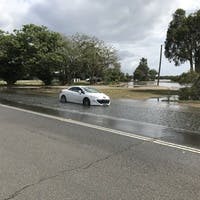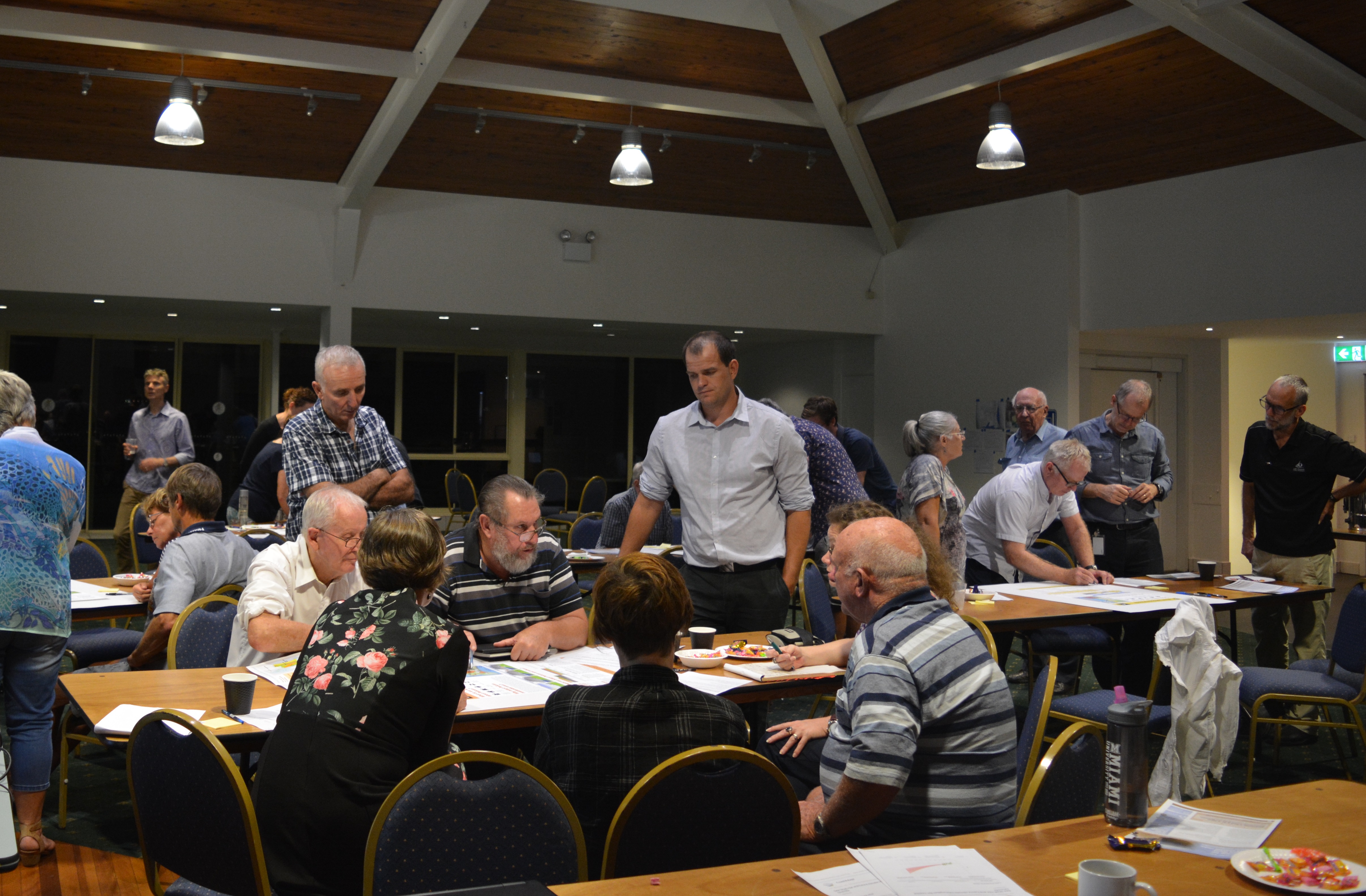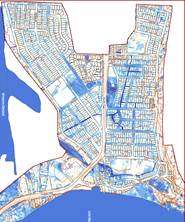Pelican and Blacksmiths: Planning for Future Flood and Coastal Risks
Council adopted the Local Adaptation Plan for Pelican, Blacksmiths, Swansea, Swansea Heads and Caves Beach on 25 October 2021. You can view the Council report here.
You can view the Local Adaptation Plan webpage for more information.
Local adaptation planning assists coastal communities that may be vulnerable to flooding and tidal inundation impacts as sea and lake levels rise. Pelican and Blacksmiths each have future flood and coastal risks unique to these areas.
Planning to adapt communities over time to mitigate future flood risks allows local residents and businesses to assess the risks early, tailor adaptation options to meet local needs and act when and where necessary. We are working together to keep our community safe now and in the future. Decisions we make can have lasting impacts. Many of the new roads, drains and homes built today will likely still be around in 50 to 100 years, so we need to plan for the future now.
This page has online resources that will keep you up to date with the development of this local adaption plan and we encourage you to provide your feedback or ask a question.
Council adopted the Local Adaptation Plan for Pelican, Blacksmiths, Swansea, Swansea Heads and Caves Beach on 25 October 2021. You can view the Council report here.
You can view the Local Adaptation Plan webpage for more information.
Local adaptation planning assists coastal communities that may be vulnerable to flooding and tidal inundation impacts as sea and lake levels rise. Pelican and Blacksmiths each have future flood and coastal risks unique to these areas.
Planning to adapt communities over time to mitigate future flood risks allows local residents and businesses to assess the risks early, tailor adaptation options to meet local needs and act when and where necessary. We are working together to keep our community safe now and in the future. Decisions we make can have lasting impacts. Many of the new roads, drains and homes built today will likely still be around in 50 to 100 years, so we need to plan for the future now.
This page has online resources that will keep you up to date with the development of this local adaption plan and we encourage you to provide your feedback or ask a question.
-
Let’s Talk: Community evacuation plans and safety during natural disasters with the SES
Share on Facebook Share on Twitter Share on Linkedin Email this linkJoin local SES and Council representatives for an evening to review community evacuation plans and how to prepare for natural disasters.
Tuesday 7 May, 5.30-7pm
The Swansea Centre, 228 Pacific Highway, Swansea
The presentation will include information about forming effective community evacuation plans, proactive safety actions during natural disasters and the process to develop a Community Action Team for Swansea and surrounding areas with presentations from SES and Council. Each forum will provide a Q&A session with the presenters.
The forum will focus on:
· Hazards affecting our local community – storms, floods, tsunamis, access during evacuation;
· Personal safety and asset protection measures at home or work;
· Home evacuation plans, safety tips and kits - when and who to call;
· Businesses – evacuation plans and business continuity plans;
· What to do and where to go during an evacuation event; and
· Community Action Team (CAT)
· Q&A with the audience
No need to RSVP, light refreshments will be provided.
Join us on Monday 13 May, for the next Let’s Talk session: Understanding the Probabilistic Hazard and Damages Assessment for Pelican, Blacksmiths and Swansea with Dr David Wainwright
-
Follow Blacksmiths Beach on CoastSnap
Share on Facebook Share on Twitter Share on Linkedin Email this linkCrowdsourcing concept to track Blacksmiths shifting sands
An innovative new concept is set to harness the power of crowdsourcing to track the ever-changing shoreline of Blacksmiths Beach in Lake Macquarie.
Known as CoastSnap, the initiative is based on a simple premise: install a mobile phone cradle at a key point along the Swansea Channel break wall where people can place their phones and take a scenic photo of the sweeping coastline to the north.
Photos can then be uploaded to the CoastSnap database via email or social media, where they are compiled to gradually create a time-lapse movie. The first output video can be viewed HERE.
Lake Macquarie City Council Environmental Systems Manager Brad Sutton said that over time, the images would reveal how the shoreline changed at Blacksmiths Beach, and how that change was affected by the movement of sand.
“Because the photos are all taken from exactly the same spot, we can get quite a precise measurement of the width of the beach, the shoreline and how it moves,” Mr Sutton said.
“The shape, location and nature of Blacksmiths Beach make it susceptible to shifting sands and shoreline changes. CoastSnap will help us better understand these processes and contributing factors.”
Researchers from the University of NSW and the NSW Office of Environment and Heritage will review the data to record short and long-term beach erosion and recovery.
A pilot project has already proven successful at Manly and Narrabeen Beaches in Sydney.
Mr Sutton urged people visiting the break wall to make use of the CoastSnap cradle and contribute to the project.
“It’s simple, quick and fun, and there is a step by step guide next to the cradle explaining exactly what to do,” Mr Sutton said.
View the CoastSnap community beach monitoring program on Facebook or State Government website.
-
King tides are coming at Christmas
Share on Facebook Share on Twitter Share on Linkedin Email this link
Seasonal king tides are expected in the days leading up to Christmas, peaking on Christmas Eve, Monday 24 December at 10.15am in Swansea Channel. If you’re out and about, snap a photo and share it with Council on our Facebook page or email [email protected]. The tide is best seen along Swansea Channel, east of the Swansea Bridge and areas adjoining Black Neds Bay.
January king tides are predicted in the days leading up to Tuesday 22 January 2019, peaking in Swansea Channel at around 10.00am.
The Bureau of Meteorology website details the 2018 and 2019 tide charts for Swansea and other measuring stations.
Want to know more? The Lake Macquarie coastline and Swansea Channel typically experiences annual king tides during December and January and again in June and July. A king tide is a naturally occurring extreme tidal event and a good preview for what sea level rise may look like in the future.
View the new tides and tidal inundation fact sheet for planning for future flood risks for more information on tides, inundation and king tides.
Tips for our community during a king tide:
- Avoid driving through areas that are experiencing tidal inundation and stay out of the water. Remember, salt water can cause corrosion;
- Continue to monitor tidal events in your local area; and
- Get involved in adaptation planning with Lake Macquarie City Council. We currently have adaptation plans underway for Swansea, Pelican and Blacksmiths, and Marks Point and Belmont South.
For further information on king tides, visit the Witness King Tides project by Green Cross Australia at witnesskingtides.org or contact the Local Adaption Planning team on 02 4921 0333. Please note Council will be closed from 12pm Monday 24 December 2018 until Wednesday 2 January 2019.
Please visit Council online at lakemac.com.au/city/emergencies or NSW State Emergency Service at ses.nsw.gov.au for information on safety during flood and tidal inundation events.
-
Leading scientist to unravel climate change mysteries
Share on Facebook Share on Twitter Share on Linkedin Email this link
A former CSIRO Principal Research Scientist will share his expertise on climate change and its links to sea level rises to help raise awareness of the issue in Lake Macquarie.
Dr Dennys Angove, now a lecturer in atmospheric chemistry at the University of Technology Sydney, will present Understanding the Science of Climate Change, on Wednesday 10 October, aiming to present a complex environmental issue in an interesting and relevant way for Lake Macquarie residents.
-
Community Group working tirelessly to progress the Pelican Blacksmiths Local adaptation plan to final stage.
Share on Facebook Share on Twitter Share on Linkedin Email this linkLate in 2016, a small group of dedicated residents joined with Council to start developing the Pelican Blacksmiths Local Adaptation Plan. Since that time, the Pelican Blacksmiths Community Working Group has met more than 30 times and spent countless hours helping their community to develop a plan for potential future sea and lake level rise.
The Plan has been designed to address current and future inundation of land and protect assets from sea level rise, higher tides, beach erosion and higher flood levels. Local adaptation plans are created specifically for the local area. It’s not a one size fits all approach and although we learn from previous experience and domestic and international examples, the plan must be custom built to address the unique environmental landscape of the local area. This could not have been achieved without the dedication and commitment of the Community Working Group.
Together, with input from the local community, the Group identified hazards in their local area that needed to be addressed in the plan, including ongoing sea level rise, higher flood levels, higher ocean tides, landward movement of the sand dunes, dune over-topping from wave run-up and storm surge and channel evolution (movement of the channel landward).
The agreed Plan objective was to adapt Pelican and Blacksmiths to the expected effects of sea level rise, in accordance with the principles of ecologically sustainable development, so that the community, economy and environment become more resilient.
One of the key successes of the Group was the development of measuring criteria to assess the adaptation options that are feasible and best meet the needs of the community, they include:
Does the adaptation option agree with our objective?
Will it work technically (does it manage the hazard in line with our objective)?
How easy is it to adapt over time? How might it affect other options?
Will it harm the environment and are impacts manageable?
Does it maintain community well-being (health, safety, financial, business and leisure)?
Will costs outweigh benefits?
Do we need additional info or advice from experts?
When is it needed / best time to implement?
Who is responsible? Who pays?
After assessing the adaptation options from the community and further research, the Groupidentified a short-list of recommended adaptation options for unique precincts in the study and planning area. They proposed a timeframe or trigger for when it was best to implement the recommended adaptation options for each precinct.
At a community workshop in April, Council and a number of the Group’s members presented these precincts to the wider community and key project stakeholders for feedback and further ideas. More than 20 community members attended to participate in this process and progress the plan.
The Group has now completed a further review of the precincts, hazards and adaptation options, which are presented in the following documents:
Precinct Planning Adaptation Concepts for Pelican Blacksmiths LAP – this booklet is a progress report on the Plan and explores the recommended precincts in more detail.
Review of Precinct Planning Adaptation Concepts for Pelican Blacksmiths – this report examines the secondary and other available adaptation options for each precinct and provides assessment for each option.
This work by the Group and Council will help inform the probabilistic hazard assessment for Pelican, Blacksmiths and Swansea that is currently being carried out by Salients Pty Ltd and the University of Queensland. Information on the probabilistic hazard assessment and the proposed cost benefit analysis will be available later this year.
The Group has done an outstanding job in identifying and reviewing hazards; assessing options proposed by the community and developing the precinct concepts for use in the next stages of the planning process.
Following the probabilistic hazard assessment and cost benefit assessment, the Group and Council will commence Phase D, in which the draft Local Adaptation Plan will be placed on public exhibition for public review then recommended to Council for adoption and implementation of the Plan.
Please view the Group’s journey timeline.
-
Let's talk: Understanding the science of climate change with Dr Dennys Angove
Share on Facebook Share on Twitter Share on Linkedin Email this linkJoin Dr Dennys Angove for an afternoon to explore the science of climate change.
Wednesday 10 October, 1-2.30pm
The Swansea Centre, 228 Pacific Highway, Swansea
Topics presented will include the structure of the atmosphere, the natural greenhouse effect, global warming, trends in greenhouse gas concentrations and the enhancement of the greenhouse effect by anthropogenic emissions.
There will be an opportunity for a Q&A with Dr Angove at the end of the talk.
Bio

Dr Angove is an atmospheric chemist and in August 2014, he retired as a Principal Research Scientist from the CSIRO Energy Flagship where he studied the effect of fossil fuel emissions on the formation of smog and ozone in urban atmospheres.
For 10 years from 2005, Dr Angove lectured in atmospheric chemistry at the University of Technology Sydney and in 2017 he joined the Environmental Humanities Group at the University of NSW as the postgraduate course convener for Managing Greenhouse Gas Emissions and now continues as a casual lecturer in the course.
Dr Angove has a GDip.Ed. and a PhD in physical chemistry from Macquarie University. He is a member of the RACI and CASANZ* as well as a volunteer for the Citizens’ Climate Lobby. He is actively involved providing science outreach talks to the community on climate change and air quality.
*RACI = Royal Australian Chemical Institute
CASANZ =Clean Air Society of Australia and New Zealand
-
Let's talk: Hazards, risks and precincts in adaptation planning
Share on Facebook Share on Twitter Share on Linkedin Email this linkJoin local representatives and Council staff for an afternoon to talk local adaptation planning and learn from the experiences of our previous plans.
Monday 15 October, 3-4.30pm
The Swansea Centre, 228 Pacific Highway, Swansea
Explore different approaches to adaptation planning and ways to custom the plan to suit the local community’s unique circumstances. The talk will highlight preliminary adaptation concepts developed during the Pelican and Blacksmiths local adaptation planning work and provide more information about sea level rise projections, hazards and associated risks to lakeside and coastal communities.
Adaptation plans are designed to address current and future inundation of land and protect assets from sea level rise, higher tides, beach erosion and higher flood levels. Local adaptation plans are created specifically for the local area. It’s not a one size fits all approach and although we learn from previous experience and domestic and international examples, future plans must be custom built to address the unique environmental landscape of the local area.
Community involvement is essential to the success of local adaptation planning, this talk is a great opportunity to hear how community representatives and Council have worked together to plan for the future.
-
Upcoming talks in October for planning for future flood risks
Share on Facebook Share on Twitter Share on Linkedin Email this link
Let’s talk: Planning for Future Flood Risks
Join expert Dennys Angove, local community representatives and Council at two upcoming information talks to better understand the science of climate change and learn more about adaptation planning through the experience of previous plans.
Understanding the Science of Climate Change with Dr Dennys Angove
Wednesday 10 October, 1-2.30pm,The Swansea Centre, 228 Pacific Highway, Swansea
View more information about this talk.
Hazards, risks and precincts in adaptation planning
Monday 15 October, 3-4.30pm, The Swansea Centre, 228 Pacific Highway, Swansea
View more information about this talk.

Dr Angove is an atmospheric chemist and previously the Principal Research Scientist from the CSIRO Energy Flagship and atmospheric chemistry lecturer at the University of Technology, Sydney. Dr Angove has a GDip.Ed. and a PhD in physical chemistry from Macquarie University.
-
Community Workshop engagement summary
Share on Facebook Share on Twitter Share on Linkedin Email this link
In April 2018, community members together with the Volunteer Working Group and Council attended a workshop to review the progress of the community's local adaptation plan (LAP) for Pelican and Blacksmiths. This summary highlights the feedback received at the workshop and identifies the next steps.
View the Community Workshop engagement summary.
Look out for the LAP progress report coming soon...
-
Stormwater model for Pelican and Blacksmiths
Share on Facebook Share on Twitter Share on Linkedin Email this link
Council has a responsibility to manage flood-liable land and in order to best understand management approaches we engaged WMAwater to establish a stormwater model suitable detailing the local stormwater flow regime in Pelican and Blacksmiths. View the Pelican and Blacksmiths 2D Stormwater Modelling Report online and if you would like any further information please contact the Adaptation Planning team on [email protected].
Let's Talk
Document Library
-
 Feasibility Assessment FAQs (172 KB) (pdf)
Feasibility Assessment FAQs (172 KB) (pdf)
-
 Options guide for the cost benefit analysis (2.72 MB) (pdf)
Options guide for the cost benefit analysis (2.72 MB) (pdf)
-
 Feasibility Assessment Report - Pelican and Blacksmiths/Swansea and Surrounds (9.86 MB) (pdf)
Feasibility Assessment Report - Pelican and Blacksmiths/Swansea and Surrounds (9.86 MB) (pdf)
-
 Let's Talk - Cost Benefit Analysis CIE Presentation 30 Nov 2020.pdf (290 KB) (pdf)
Let's Talk - Cost Benefit Analysis CIE Presentation 30 Nov 2020.pdf (290 KB) (pdf)
-
 CBA Report Executive Summary.pdf (188 KB) (pdf)
CBA Report Executive Summary.pdf (188 KB) (pdf)
-
 Probabilistic Hazard Assessment.pdf (14.5 MB) (pdf)
Probabilistic Hazard Assessment.pdf (14.5 MB) (pdf)
-
 Records of wider community engagement
Records of wider community engagement
-
 Newsletters
Newsletters
Who's listening
-
Lake Macquarie City Council
Phone 02 4921 0333 Email [email protected] -
Senior Sustainability Officer – Climate Change Adaptation








